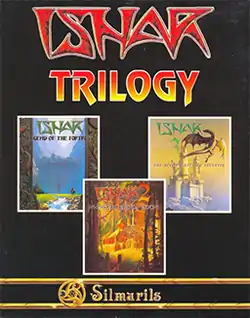Ishar
Ishar is a series of three role-playing computer games by Silmarils for the PC, Amiga, Atari ST, Atari Falcon and Macintosh platforms. They are preceded by Crystals of Arborea, which is sometimes nicknamed Ishar 0.
| Ishar | |
|---|---|
 Cover art for the compilation edition containing all three games of the series. | |
| Genre(s) | Role-playing |
| Developer(s) | Silmarils |
| Publisher(s) | Silmarils |
The games are all played in first-person perspective, with all but Crystals of Arborea allowing the player to direct a group of five characters, each with a selectable race, gender, and class.
Crystals of Arborea
Crystals of Arborea was published by Silmarils in 1991. It precedes Ishar both chronologically and by its gameplay. Morgoth, the main antagonist of Crystals of Arborea, is the father of Krogh, the one of Ishar: Legend of the Fortress. Moreover, most of the heroes of the game, Jarel's companions, can be met in Ishar or even in Ishar 2.
Ishar: Legend of the Fortress
The first game in the series came out in 1992 on Amiga, Atari ST and DOS. It takes place on the island of Kendoria. At the beginning, the player controls a warrior called Aramir, and he must defeat Krogh, an evil sorcerer who has killed lord Jarel. The game takes its name from Krogh's fortress, Ishar, whose name means "unknown" in the game's fictional elf language. In order to achieve this, the player's characters must travel across the whole island and, among other things, meet with the surviving companions of Jarel.
Most of Ishar takes place in an outdoor environment, which was original for computer roleplaying games of the time. It also featured a unique system to change the lineup of player characters: the player can have up to five characters at the same time, but each one will like or dislike his comrades. These preferences come into play when the player tries to recruit or dismiss a character, because the other characters will then vote for or against the recruitment or dismissal. If a character cannot be dismissed by a vote, it is possible for the player to have him assassinated by another character, but there is a risk that other characters will murder the murderer himself, possibly creating a chain of murders that slays the whole party but one.
This opus was the only one of the series that had gold removed from the party each time the player saved.
The band Summoning used the cover art of the game for their album Minas Morgul.
Ishar 2: Messengers of Doom
Ishar 2 was published in 1993 on Amiga, Atari ST and DOS. In Ishar 2, the player starts with the character of Zubaran, who is the new lord of Ishar. He receives a vision that tells him to defeat the sorcerer Shandar. It is also possible to import a party of characters from the first Ishar. The game now takes place on an archipelago, each island bearing the name of one of Jarel's companions. Each island also features a different type of landscape: Irvan's island is covered with swamps, Akeer's and Otbar's are underground complexes, Zach's island is covered by a city, Jon's is mountainous, and Thorm's has treetop gangways in a forest.
This game has a combat system that's more ergonomic than in the first Ishar, and a day-night cycle in which shops are closed at night and the nightclub is closed by day. It also adds a bank. Saving the game does not remove gold from the player anymore.
Ishar 3: The Seven Gates of Infinity
Ishar 3 was published in 1994. The player starts with Zubaran or imports characters from another game of the series, and has to hunt the dragon of Sith. In order to do that, he needs to cross a series of gates, each one sending him to a different time period. Each period, like the islands of Ishar 2, has its own climate and type of landscape.
Ishar 4: Ishar Genesis
A fourth game in the series, Ishar 4, was in development and announced in 1995 for the Atari Jaguar CD under the working title Ishar Genesis and was intended for a December 1995 release but development was discontinued for unknown reasons.[1][2][3][4][5] Former Silmarils programmer Cyril Cogordan stated that ideas created for the unreleased fourth installment were later implemented in Asghan: The Dragon Slayer, released three years later.[6]
References
- "Dossier - Ils Arrivent Sur Jaguar - Ishar Genesis / Jaguar CD". CD Consoles (in French). No. 5. Pressimage. March 1995. p. 75. Archived from the original on 2018-09-24. Retrieved 2019-01-05.
- "Jaguar Tackboard - AEO Development List 2.04 - Titles in Development". Atari Explorer Online. Vol. 4 no. 4. Subspace Publishers. March 28, 1995. Archived from the original on 2016-03-03. Retrieved 2019-03-27.
- "Cahier Loisirs / Avant première - Exclusif: Silmarils Et Le Jaguar". ST Magazine (in French). No. 93. Pressimage. April 1995. p. 59. Archived from the original on 2018-09-24. Retrieved 2019-01-05.
- Nepožitek, Marek (July 1995). "Konzole - Jaguar+CD - CD a virtuální realita již tento rok?". LeveL (in Czech). No. 6. Naked Dog, s.r.o. p. 44. Archived from the original on 2018-09-20. Retrieved 2019-01-05.
- Wasabim (October 7, 2017). "INTERVIEWS - Fabrice Hautecloque". atarilegend.com. Archived from the original on 2018-09-24. Retrieved 2018-09-24.
I left Silmarils by the end of Ishar 3, So I have very little information. But yes, I did hear about the project, but that is about all I can say sadly. I guess you will have to contact André or Louis-Marie, if you really want to know what happened to that project ;-)
- Moreau, Frédéric. "Interview de Cyril Cogordan programmeur de Ishar 3 et Robinson 's Requiem". jaguar-64bit.pagesperso-orange.fr (in French). Archived from the original on 2018-02-16. Retrieved 2018-09-24.